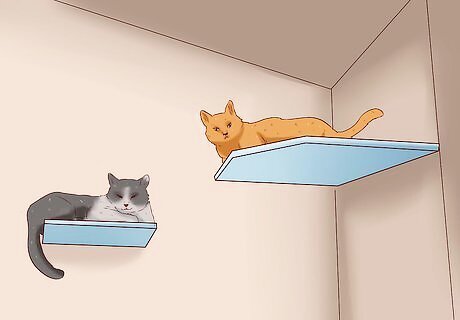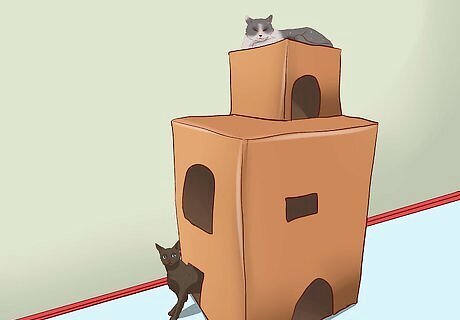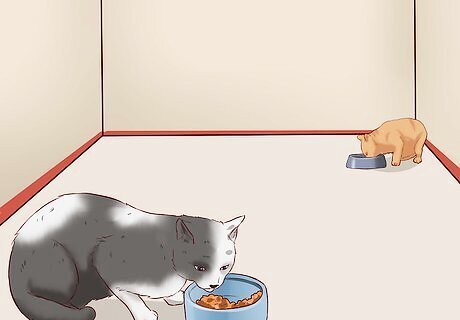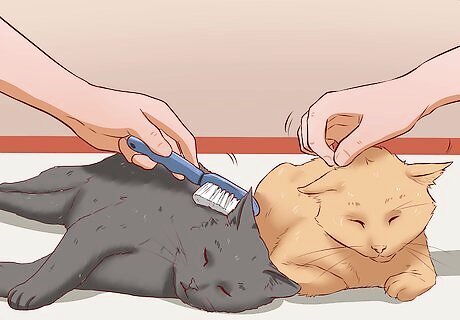
views
Introducing the Cats Properly

Allow the cats to smell each other before meeting. Keep the new cat in a separate room so the other cats can smell her through the door. You can use your bathroom if you don’t have a spare room. Give the established cat something with the new cat's scent on it to sleep on. The ideal object is a T shirt with your scent on it that the new cat has sat on. This uses your scent as a "intermediary" and gives the established cat a gentle introduction. It may take a few days for your cats to not freak out or avoid your new cat’s bedding. But over time, they should start to get used to the new scent. As a general rule, it is usually best to introduce a new cat when your existing cat is young. This will allow the two cats to get to know each other over a long period of time and hopefully bond as they grow.

Let the cats observe each other before they physically meet. If you are planning to get a second cat or to add another cat to your household, it’s important that you ensure they get along by introducing them properly. This means letting the cats see each other before they touch each other or interact. Consider placing the new cat in a cat carrier and placing this on the floor for the existing cat to sniff around and investigate, without the threat of being chased by the new cat. Alternatively, use a baby gate that is at least 36 inches high. Place it in the doorway of the new cat’s room so she stays in her room and does not interact with your existing cat(s). Allow the cats to get a look at each other. Then, praise and reward both of them with a treat if there is no attacking or signs of aggression like hissing. Make sure the cats look at each other five to ten times a row, two to three times a day.

Pay attention to the body language of both cats. Before you allow the cats to physically interact with each other, you need to ensure they have grown used to each other by smell and by sight. They should seem relaxed and calm when they look at each other and be okay with being in each other’s presence for an extended period of time. If either cat starts to hiss, growl, or seem uncomfortable, move them out of each other’s sight. Keep the baby gate door closed to the cats cannot interact with each other. Always quit while you’re ahead and don’t force the cats to get along. Patience is key as it may take some time for your cats to accept each other.

Play with the cats together. Once your cats seem comfortable looking and smelling each other, you can start to encourage them to interact. Use a fishing rod type toy to play with the cats at the same time. You should also give each cat her own toy to play with. This will help the cats to associate being around each other with play time. If one cat starts to act aggressive, use the fishing rod toy to distract and redirect the cat. However, if both cats display any aggression or tension, separate the cats and return them to their separate spaces. You should never leave the cats alone to play until they seem comfortable and accepting of each other. If the cats play well together, reward them both with treats and praise. It’s important to always reward both cats so they understand they are equal and there is no preferential treatment.
Adjusting the Living Environment

Provide separate litter trays, feeding stations, and beds for each cat. Giving each cat her own litter tray, food bowl, and bed will cut down on any feelings of competition and reduce stress among your cats. Try to keep the separate litter trays, feeding bowls, and beds for each cat identical so it does not seem like one cat is being favored over the other. Place the feeding bowls a safe distance from each other so your cats can eat in the same room but in separate areas of the room.

Create vertical spaces for each cat. Cat trees, cat friendly shelves, and tall perches on furniture can help your cats feel comfortable roaming around the space or room without having to share a vertical spot. Cats often feel safer when they can observe things from above and when they can move away from other cats or people on their own. You can also place separate scratching posts in doorways or at the top or bottom of the stairs so your cats can learn to play in the same area, but on separate posts.

Make a cardboard playground for the cats. Cats love to run around and explore on high perches in a playground made of cardboard. You can also use paper bags, with the handles removed, and cardboard tubes to create a fun playground for each cat. Rotate the objects often to keep the playground interesting for both cats. Make sure the playground has multiple exits so your cats do not feel trapped together or boxed in when playing.

Feed the cats in separate rooms or on opposite sides of the room. Feeding time can be a big source of tension and competition for cats. Reduce any stress or anxiety for your cats by giving each cat food in their own feeding bowls in different areas of the room.
Dealing with Conflicts

Stop the fighting by clapping your hands or spraying a water bottle. Avoid letting your cats just fight out their issues. Cats can’t really resolve any problems through fighting and fighting will often make the conflict worse. Interrupt or stop any fighting by clapping your hands loudly or spraying a warning shot from a water bottle or gun. Avoid yelling at them to stop fighting or displaying open aggression by throwing an object at them. This will create more stress and possibly more fighting down the road. Instead, calmly interrupt the fight. You can try to distract the cats with toys to prevent the fight from starting up again. You should also avoid trying to soothe the cats after they have had a fight. Instead, leave them both alone once they separate and stop fighting. Due to their solitary nature, cats are often best left alone to recover from a conflict.

Use a calming pheromone spray. Some cat owners have found a calming pheromone spray like Feliway can help to reduce overall stress levels in the living space. You can also get Feliway in the form of a plug-in diffuser that releases the calming pheromone throughout the home. The spray may not work on all cats to calm them down and it may not stop every conflict from occurring. But it can help to maintain a calm, stress free environment in the living space for both cats.

Groom and interact with each cat equally. Often, two fighting cats will be looking to their owner to help them process the stress and anxiety of having to live with each other. Observe their behavior towards you and if you notice any signs of stress, such as tense body posture, twitching tails or dilated pupils, respond by giving the cats some attention. Do this by playing with both cats at the same time, using two separate sets of toys. You can also groom your cats to give them some love and attention. Rub their bellies and their heads, but avoid picking them up and carried them or cuddling them. Most cats get stressed out when held and prefer to be groomed on the ground. Some cat owners have found rubbing tuna juice on their cats’ bodies and heads can help to distract the cats from fighting. Your cats may be come so occupied with grooming and licking the tuna juice that they may not pay much attention to each other. In fact, they may start grooming each other to get at the tuna juice and could interact in a more friendly way.

Talk to your vet if your cats continue to fight. Sometimes cats can fight due to stress or anxiety from a medical condition or issue. Bring your cats to the vet for check ups to determine if there could be other reasons for their fighting. You can also contact a Certified Applied Animal Behaviorist (CAAB or ACAAB) or a board-certified veterinary behaviorist for advice and guidance on how to encourage your cats to get along at home. You can find a list of CAABs here. Keep in mind some cats just aren’t meant to live together in peace. Chronic stress and tension in their living space is not healthy for your cats and could lead to some unhappy cat years. If you have exhausted all of your options, you may want to consider separating the cats permanently by finding a new home for one cat or restricting one cat to a completely separate area of the house.




















Comments
0 comment